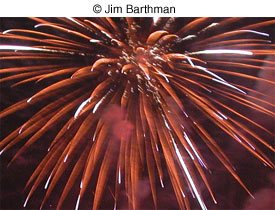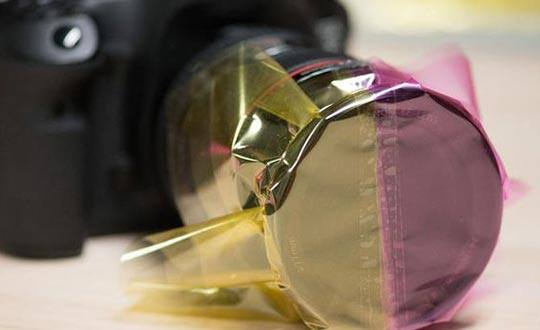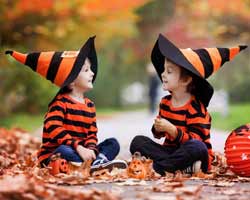This article on digital photography fireworks tips is part of our special series on photographing fireworks. You can also view our other Fireworks Photography articles on How to Photograph Fireworks and Photographing Fireworks in Your Backyard.
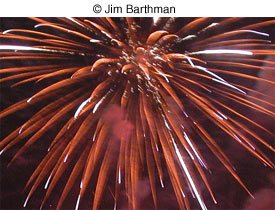
I was recently asked to photograph a local fireworks display. No problem, I thought, I love fireworks and I've shot enough of them to feel absolutely confident that I could provide the client with some great photographs. There was one twist however; because there was a need for a quick turnaround on a holiday weekend, the client asked that I use a digital camera.
My enthusiasm was quickly replaced by a mild case of insecurity. I have been shooting fireworks with film for years with great success. My confidence is a direct result of that familiar experience. Why mess with success? The client insisted the deadline was tight and the printer wanted a digital file, and there was no budget for rush film processing and scanning. Digital it had to be.
Make no mistake about it — I do love digital photography. I just didn't think that my digital point-and-shoot camera was the ideal tool for this job. So as my left brain processed a profusion of technical questions, my right brain apparently triumphed. I replied, “No problem, I'd love to shoot the job for you."
Regardless of the camera equipment you use, making good photos of fireworks can be challenging. Here are some tips on digital fireworks photography as well as some basic things to consider whenever you are shooting a pyrotechnics display.
Arrive early.
Take a little time, before the show, to scout the location. Chat up the pyrotechnic crew if possible. To get the best fireworks photos with a digital camera, point-and-shoot or DSLR, try to determine where the fireworks will be launched and then try to find a clear, unobstructed view that meets your compositional requirements based on the terrain, the height at which the fireworks will explode, and your lens choices.
Position yourself wisely.
You don't want to be in the middle of a crowd, with people wandering in front of the camera or worse kicking your tripod mid-exposure. Steer clear of artificial light sources such as streetlights to avoid the possibility of light flare. Watch out for tree branches that can sneak into your composition too.
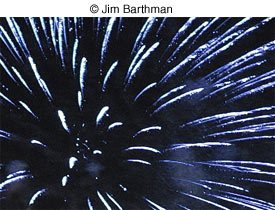
Always use a tripod.
Capturing the light trails of an aerial display requires long exposure times. Long exposure times require camera support to ensure sharp exposures. Whether you're using film or a digital camera, bring a sturdy tripod.
Don't forget the cable release.
Another way to increase camera stability is to use a cable release. A cable release ensures that you won't have to physically touch the shutter release thus eliminating the possibility of camera shake. Many digital cameras won't accept a standard cable release. Some require a specific electronic remote triggering device. Check with the camera manufacturer.
Bring a small flashlight.
Since you are going to be shooting in the dark bring a small light so you are not fumbling with your camera's controls and settings, not to mention changing memory cards etc. I use a small, Maglight® flashlight. It's lightweight yet sturdy, turns on and off with a quick twist-of-the-wrist, and goes forever on a couple of AA batteries.
Bring extra batteries.
You'll want to take lots of pictures, so have a backup battery in the event that your primary battery gives out during the show.
Bring plenty of memory cards.
I admit it. I am guilty of running out of film during a fireworks show. Don't get so excited in the beginning that you fill your card before the grand finale. That's when the pyrotechnic pros get to show-off their most impressive aerial displays. A good finale will produce peak light, color, and excitement. So make sure you have ample storage space available when the “big guns” go off. Also make sure that your batteries have enough power to photograph the finale. You aren't likely to have time to change them when the final bursts are headed skyward.
Fireworks Mode.
You've got to hand it to camera designers — they've dreamed up a number of exotic modes that appear on some camera models. What exactly is “party mode?” That's outside the scope of this article, but there are a few cameras which feature a “fireworks mode” that will give a long exposure. Don't worry if your camera doesn't feature a whole host of “modes.” Most of them are baby steps for inexperienced photographers. If your camera has manual settings, just figure it out using the manual or trial-and-error going through the menus.
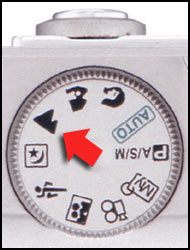
For Focus — Landscape Mode.
Most digital point-and-shoot models don't allow you to turn off autofocus, so your camera may get confused when it's pointed up into the night sky with nothing for the focus sensor to detect. To get around this, there's a handy mode — landscape. Set your camera to Landscape mode, if it has one — typically designated by an icon that looks like a small mountain range. It's the same as setting the lens on a film camera to Infinity. With the camera in Landscape mode you won't have to concern yourself with focusing issues.
Use the highest Quality-setting.
By choosing a high Quality-setting you will reduce the amount of compression applied to your images. JPEG compression degrades image quality and can even introduce artifacts into your image. This is a particular problem for this subject matter because compression artifacts are typically found in areas of high tonal and color contrast, like the bright colored light of fireworks bursting against an inky black sky. Less compression means fewer image artifacts and ultimately better image quality. Don't expect to be able to take photos of fireworks with a digital camera in RAW. Your camera will likely take too much time to write the image to the card and you'll miss getting some pictures.
Exposure.
Shooting with a digital camera is somewhat like shooting slide film. If you're not careful, you can overexpose and lose detail in the highlights. Since fireworks are, by definition, highlights, using a digital camera to capture them can be tricky.
You'll need to be able to control how long the shutter is open. For fireworks photos, I expose anywhere between 1 and 4 seconds. Shorter exposures don't always capture the full burst and longer exposures tend to produce washed-out results. Since the shutter speed must be long enough to record the explosion of the shell, I control the exposure by choosing the correct aperture size.
If you have a B (Bulb) shutter speed setting you can use it to control exactly how long your shutter is open. This is always my choice. The trick is to open the shutter right at the beginning of the burst and close it when it reaches its peak. Anticipating the explosion can be difficult, but not impossible. If you don't have a B setting you can choose a fixed setting, such as 1 second.
Using one of the suggested apertures listed below, you can use your preview to test and then compensate the aperture accordingly.
The aperture you use will be based on the ISO setting of your camera or film.
| ISO SETTING | APERTURE RANGE |
|---|---|
| ISO 50 | ƒ/5.6 to 11 |
| ISO 100 | ƒ/8 to 16 |
| ISO 200 | ƒ/11 to 22 |
This chart will work with most digital cameras that allow you to set shutter speed and aperture. While most film-based point-and-shoot models won’t allow you to do this, most of the sophisticated digital point-and-shoot models permit the photographer to set these controls. If you've never done this before, you'll have to figure out how to use these controls by looking at your camera's instruction book. If you're using a digital SLR, then try these settings too.
Some basic point-and-shoot digital cameras have only an ISO speed of 100. I don't suggest that you change it. Even if your camera does offer higher ISO settings, you'll want to choose the lowest one you can use effectively. That suggests that your correct aperture will be somewhere between ƒ/8 and ƒ/16. As I mentioned earlier, watch the first few explosions of the fireworks show in the camera's preview. You don't want the exposure to wash out the colors of the red, blue and green bursts. They should appear clearly, but they should show their actual color rather than wash out to a yellow/clear tone.
Weather can affect exposure.
Ever-changing weather conditions can add yet another variable to the already difficult assignment of taking photos of fireworks with a digital camera. Even a light mist or fog can reduce visibility substantially and, as a result, affect exposure. Compensate accordingly.
Reduce the noise.
Long exposures, higher ISO settings, and even higher temperatures can introduce noise into your digital photographs. Noise is typically visible in very dark or black areas evidenced by colored pixel artifacts. Although you can't avoid long exposures when shooting fireworks, you can choose a lower ISO setting. Increasing the ISO on your digital camera is like turning up the volume on your radio. By amplifying the signal suddenly every pop and crackle can be heard. That's why I don't recommend using a faster ISO.
Noise Reduction Techniques Using Adobe Photoshop.
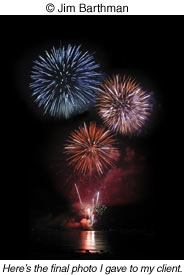
One way to reduce noise in a digital image is to make a black frame during the shoot and then sandwich it with the noisy shot. To make a black frame, place the lens cap over the lens and make an exposure using the same settings that you used during your shoot. I usually try to make one of these exposures before I start shooting, and then another one at the end of the shoot. That way I won't forget.
In Photoshop:
- Open the black frame file alongside an image that has noise.
- Shift + Drag the black frame Background layer over the noisy image workspace to create a new layer. (Holding the Shift key ensures that the new layer maintains perfect registration.)
- Change the Layer Mode of the black frame layer to Difference.
The noise should be reduced significantly.
Other noise reduction techniques.
Are you sensitive to loud sounds? You might consider purchasing disposable earplugs designed to protect your delicate eardrums. You can find them at most good pharmacies. Fireworks shows can be loud! The noise should be reduced significantly.
It's always more comfortable to travel down paths that are most familiar to us. But every now and again, it's a good idea to take the unexplored route. You may not go anywhere. On the other hand, you may discover something new and unexpected. Occasionally you'll stumble upon something extraordinary. That's when the fun really starts.
We recently received an e-mail from an avid NYIP.edu reader who had a comment on Jim's article that will be of interest to people trying to shoot fireworks with a digital camera that is older and slower than newer models.
“I enjoyed your article about fireworks and digital. It caught my attention, partly for my long standing interest in capturing fireworks on film (spanning 30+ years of shooting fireworks photos with roll film). I read the article after having my own experience with digital and fireworks. I was surprised to find that you never even mentioned something that I recall being an issue for me. It is a situation that can affect some but not everyone so there is the chance that you were not affected at all. However, I know that others reading your article could be affected so I bring it up for this reason.
A couple years ago, I got into the digital camera thing to the point that I pretty much parked my roll film cameras. At the time, I was doing documentation for publishing on the web and needed digital much more than prints. I was shooting scenes and people, basically capturing the moment. Any photography shoots I did were controlled by me; I decided when to take the exposure.
When the 4th of July rolled around, I was busy with other things and didn't plan on shooting any film at all. When the fireworks got started, here I was with the digital camera and couldn't resist. Even though the camera didn't have a lot of control, I was able to get some pretty fantastic shots. The one thing that caught me off guard was the time between exposures. I knew about it but I hadn't thought about it because I previously had not had the need to. My normal 'fireworks' shooting method fell apart. I suddenly realized that when I had shot fireworks with a film camera, that I could essentially capture every projectile, but with the digital, I had to wait until the image was captured to the CCD device and the camera was ready for the next shot. I missed some shots that I think looked better than the ones I was waiting on the camera to store.
Granted, my experience was based on the cameras that I used. Digital cameras as a whole are getting faster so the problem will be reduced if not eliminated in the future but for now it is still pertinent.”
Be sure to read these new fireworks photography articles!
Go to NYI's How to Photograph Fireworks
Go to NYI's Photographing Fireworks in Your Backyard

